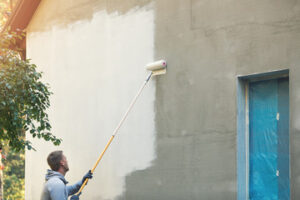Home » Articles posted by Teresa Schaffer
Author Archives: Teresa Schaffer
How to Design a Concrete Driveway
Concrete is a functional material that lends itself to a wide variety of design options. Its versatile appearance and low maintenance make it a preferred paving choice for many homeowners.
Unlike asphalt driveways that use non-renewable petroleum supplies, concrete pavements are made from natural resources, including water, rock, sand, and cement, which can include recycled or waste materials such as fly ash, ground blast furnace slag, or silica fume. For professional assistance, contact Concrete Contractors Colorado Springs.
Concrete is used to build the world around us, including homes and driveways. It’s an extremely durable material, and it can withstand more traffic than other paving materials, such as asphalt and gravel.
A concrete driveway can last up to 50 years or more with regular maintenance and care. However, if the wrong type of concrete is installed or it’s exposed to harsh weather conditions, the life of a concrete driveway may be significantly shorter.
When a concrete driveway is constructed, it’s often mixed with other materials like limestone, steel mesh, or rebar to reduce the chance of premature cracking. It’s also usually poured over a subgrade of crushed rock or gravel to increase its strength and durability.
Unlike pavers, which can break or shift over time, a concrete driveway will stay in place because it’s not made of individual pieces. It’s also much cooler under the blazing summer sun and easier to clear of snow in the winter.
Concrete slabs can be poured to a thickness of 10 or 12 inches, and they’re usually reinforced with wire or rebar to make them stronger and more resistant to damage. They can also be textured to create a unique look for the surface.
Some common problems that can affect the durability of a concrete driveway include natural settling and water damage. If a driveway is installed on a slope, it’s important to correct the drainage to prevent moisture from pooling underneath the slabs. It’s also crucial to use a high-quality penetrating sealer on the concrete once a year to protect it from dirt, mold, and mildew.
Stress cracks are another common issue that can occur on a concrete driveway. These cracks are typically caused by temperature changes, heavy loads, or soil movement. Filling in these cracks is a simple process that doesn’t impact the structural integrity of the concrete.
Appearance
The driveway is one of the first things people see when approaching your home, and it’s an opportunity to make a statement. Whether you want to spruce up your driveway to complement your home’s aesthetic or boost its resale value, there are several design options that can transform the surface into something eye-catching.
Concrete is an excellent material for a driveway, especially when it is combined with aggregate like gravel. The texture of the aggregate and the smoothness of the concrete create a visual and tactile contrast that many homeowners find attractive. Unlike asphalt, this type of concrete driveway is long-lasting and doesn’t require frequent resurfacing.
Another way to add visual appeal to a concrete driveway is by etching or stamping it with a pattern before it sets. This is often done with new concrete, but it can also be used to enhance an existing driveway. A popular choice is a herringbone pattern that adds interest to an otherwise plain concrete surface. Other patterns that are commonly seen on concrete driveways include geometric shapes, a basket weave, and hexagons.
In addition to etching and stamping, you can also use colors to alter the look of your concrete. A common color scheme is two shades of gray or tan, but you can experiment with different combinations to find the perfect match for your home. Another option is to use concrete stain to give the concrete a natural, mottled appearance.
If you are looking for a more rustic charm, consider adding cobblestones to your concrete driveway. These stones are a classic addition to any landscape and offer both durability and old-world elegance. Unlike their natural counterparts, which are prone to shifting, concrete cobblestones are long-lasting and easy to maintain.
While it is possible for a homeowner to pour their own concrete, this is usually a job left to professionals who have the equipment and experience necessary to get the project done quickly. A professional crew can usually complete the excavation, form preparation, and concrete pour in a day or two. The poured concrete will then need to set for a few days before it can be leveled and finished.
Easy Maintenance
Concrete is a reliable and durable paving solution that adds value to your home. It is low-maintenance but should be sealed regularly to protect against weather damage and staining from oil and other fluids. Consult with local concrete driveway specialists to find out more about this trusted paving option and how you can bring your dream driveway design to life.
Mark uses a Brute Bosch jackhammer to break up the old concrete, then compacts the base soil and gravel with a Wacker Neuson VP1340 plate compactor. He then adds a layer of tack cloth, followed by a strip of mesh wire, to reinforce the concrete. Mark and Britt then use an edging tool to smooth and shape the edges of the concrete. They finish by adding a brushed texture, which looks more natural and helps with skid resistance.
When they are ready to pour the concrete, Mark and Britt mix the materials together using a power mixer. They then follow the template they created with a straight edge to create the correct size and shape for the concrete. Once the concrete has a smooth surface, they pour it and level it. They let the concrete set for two days, then they could start driving on it. After 28 days, they should apply a sealer to the concrete to keep it protected.
Regularly cleaning the concrete with a hose and scrub brush will help keep it in good condition. Concrete sealer will also help protect the concrete from harsh winter weather and chemicals used in snow removal, like road salts.
Keeping trees and large bushes far enough away from your concrete driveway will reduce the risk of roots growing under the slab and causing cracks. It is also a good idea to clean out the gutters frequently so that water doesn’t flow down the driveway and freeze. This can cause the concrete to expand and crack over time. Using a concrete patching kit to fill in cracks and holes will also protect the concrete from further deterioration. To ensure the longevity of your concrete driveway, make sure to have it filled in as soon as the cracks appear and seal it every two years to protect it from oxidation.
Value
Concrete is a durable, long-lasting material that adds significant value to your home. If you have an old, cracked, or deteriorating asphalt driveway, replacing it with a new concrete one will make your house stand out in the neighborhood and likely increase its resale value. Concrete is also a practical option for your driveway if you have a large vehicle, such as an RV or trailer. In addition to being more durable, a concrete driveway is easier on tires and less prone to punctures than an asphalt one.
Concrete contractors can work with you to find creative visual design options for your concrete driveway, adding unique curb appeal that enhances the beauty of your property and home. However, a plain gray concrete driveway is a tried-and-true choice and remains a budget-friendly option.
The cost of building a new concrete driveway depends on several factors, including its size and shape, site preparation, and labor costs. A curved driveway will cost more to build than a rectangular or square option, and a contractor may have to specially build concrete forms for this type of project. In addition, a poured concrete driveway requires a proper sub-base that will be graded and compacted to provide strength and stability.
A reputable contractor will take the time to prepare the site for a concrete driveway by removing existing materials and ensuring that the soil is properly graded and compacted. This will ensure that the concrete is well bonded to the ground, creating a strong and long-lasting surface.
Concrete is a natural material that will last longer than asphalt, saving you money on future repairs and replacements. In addition, a concrete driveway will not be susceptible to the same damage as an asphalt one, such as cracking, distortion, or disintegration due to UV exposure and weather conditions. It also uses less energy, as it doesn’t have to be heated and melted like an asphalt driveway. As a result, it reduces carbon emissions and energy consumption in your home. To further conserve energy, a concrete driveway reflects more light than an asphalt surface, further reducing your home’s need for lighting.
How to Hire a House Painter
If you want to know how to hire a professional painter, you’ve come to the right place. Visit Website to learn tips on hiring a painting company, how much paint you need, and more.
If you’re looking to paint your home, you’ll need to take the time to choose a painting contractor who can provide you with a quality finish. Using a professional to do the job can add thousands of dollars to the total cost.
It can be a stressful process to hire a painter, but you can make the process much easier by asking a few questions beforehand. You can also check online for reviews and get recommendations from friends and neighbors.
The price of a painter can vary widely, depending on their experience level and the complexity of the job. The final price will include the costs of materials and labor. Typically, it costs around $2 per square foot to paint a room.
Depending on the type of paint you choose, the overall cost of the job can vary from a few dollars to several thousand dollars. Paint and materials will account for about 20% of the final cost.
When hiring a professional painter, it’s important to ask about insurance and warranties. This will protect you from liability. Generally, a painting contractor should charge at least 10 percent of the job’s total cost for the down payment.
For larger projects, the price can be more expensive, especially if you’re hiring an expert. Some of the more complicated jobs require special skills, like spray painting or lead removal. Painting your walls can be a great way to increase the resale value of your home.
The cost of hiring a painter will vary based on the size of your house. A small apartment will only cost you about $200 to paint, while a 4,000-square-foot house can cost a couple of thousand dollars.
To give you an idea of how much the painting project will cost, you can use the painting estimate calculator. It will calculate the cost based on your area, including the number of gallons of paint and the types of products you need.
Before you start the painting project, prepare the area to be painted. You’ll need a certain amount of time to let the paint dry. There are other factors to consider, such as humidity, wind, and temperature.
House painting is a daunting undertaking. It requires you to put your best foot forward in order to ensure that the outcome is a rousing success. For example, you should be able to identify the difference between a mediocre paint job and an eminently acceptable one. In addition, you should also pay attention to the quality of the house painters’ tools and materials.
One of the biggest mistakes you can make is to not bother with all of the small details. This includes preparing the room for painting. By ensuring that you clean off all the dirt and grime before you start, you will be rewarded with a better final product. You should also consider the type of flooring you have before you set about your painting mission. Painting a kitchen or bathroom is particularly tricky because you don’t want to end up with oil splatter on your walls. To avoid this pitfall, be sure to apply a layer of degreaser first.
As with any home improvement project, you should be prepared to put in the hard yards. Not only should you prepare your surfaces in advance, but you should be sure to properly store your tools and materials as well. The best part is that you can do all of this for less than you would pay for a professional painting service. And, as a bonus, you will be able to enjoy the results yourself!
The best way to do this is to plan out your entire project beforehand. The end result will be a more polished and professional-looking house. Having a game plan will not only keep you on track but also ensure that you get to enjoy your newly repainted space. So, if you have been itching to freshen up your home, make sure that you put your best foot forward and don’t be afraid to do a little research! Whether you are a novice or a seasoned professional, you should be able to paint your house for less than you might pay to have a pro do the job. Do your homework, and you’ll be on your way to a more aesthetically pleasing space in no time at all.


